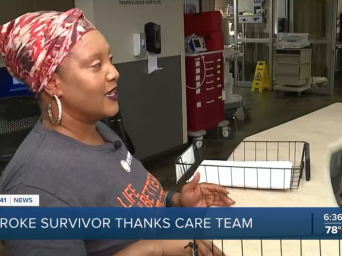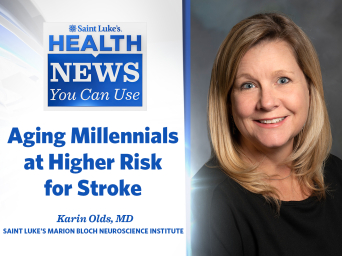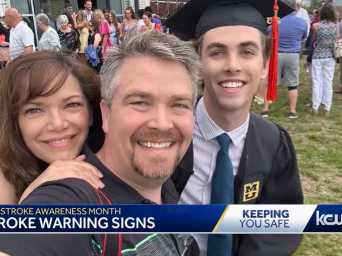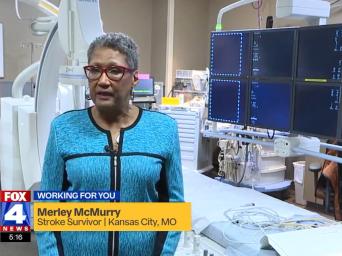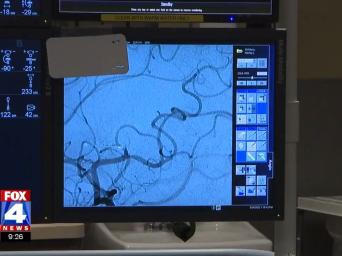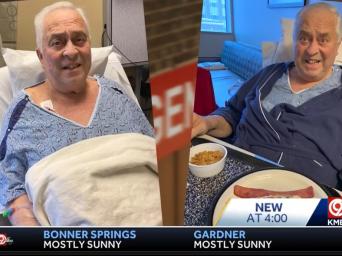Stroke
The brain needs a constant supply of blood to work. During a stroke, blood stops flowing to part of the brain. Most strokes are caused by a blockage in a blood vessel that supplies the brain (ischemic stroke). They can also occur if a blood vessel in the brain ruptures (hemorrhagic stroke).
A stroke can damage areas in the brain that control the rest of the body. Get help right away, if symptoms come on suddenly, even if the symptoms don’t last.
Saint Luke’s Marion Bloch Neuroscience Institute is a national leader in stroke reversal. We treat 4,000 suspected strokes each year.
Our brain and stroke experts are:
- Among the nation’s elite at coiling and clipping to treat hemorrhagic stroke and aneurysm
- Fastest in the region at delivering tPA, the clot-busting drug that stops brain damage caused by ischemic stroke
- Pioneers in using clot-removal devices
The leading edge of stroke care
The Joint Commission recognizes Saint Luke’s Hospital as a Comprehensive Stroke Center, and the state of Missouri designated us a Level I Time Critical Diagnosis Center for Stroke. Nationally, Saint Luke's beats key benchmark numbers for stroke care:
- Our patients are more likely to be treated with clot-busting tPA than at other facilities—we give tPA 22 percent of the time, while the national rate is 13.2 percent.
- Saint Luke’s interventional radiologists open blocked brain arteries in 87.5 percent of cases—30 percent better than the national average.
- Our complication rates following clot removal are 3.8 percent compared to 7 percent nationally.
Designed for speed and efficiency
Speed matters. Every second of a stroke kills 32,000 brain cells. Our Neuroscience Institute was designed to offer the fastest, most accurate care for stroke and brain injury.
- From the ambulance entrance, EMS crews wheel patients directly into our computed tomography (CT) scanner room, where our team is ready to go—saving more than a dozen valuable minutes right from the start.
- Many patients receive intervention before an hour has passed.
- We have four dedicated neurosurgical operating suites, 68 private rooms, and 18 state-of-the-art ICU rooms.
Our speed and skill mean Saint Luke’s stroke patients retain more brain cells—and more function.
Symptoms
Symptoms of a Stroke
During a stroke, blood stops flowing to part of the brain. This can damage areas in the brain that control the rest of the body. A stroke can happen to anyone at any age. Call 911 and get help right away if any of these symptoms come on suddenly, even if the symptoms don’t last.
Know the symptoms of a stroke

-
Weakness. You may feel a sudden weakness, tingling, or a loss of feeling on one side of your face or body including your arm or leg.
-
Vision problems. You may have sudden double vision or trouble seeing in one or both eyes.
-
Speech problems. You may have sudden trouble talking, slurred speech, or problems understanding others.
-
Headache. You may have a sudden, severe headache.
-
Movement problems. You may have sudden trouble walking, dizziness, a feeling of spinning, a loss of balance, a feeling of falling, or blackouts.
-
Seizure. You may also have a seizure as the first symptom of a stroke.
When to call 911
Remember: If you have any of these symptoms, or if someone you are with has these symptoms, call 911 as soon as possible.
Never drive yourself or the victim. The ambulance can alert the hospital and start treatment.
B.E. F.A.S.T. is an easy way to remember the signs of a stroke. When you see these signs, you will know that you need to call 911 fast.
B.E. F.A.S.T. stands for:
- B is for balance. Sudden loss of balance or coordination.
-
E is for eyes. Vision changes in one or both eyes.
-
F is for face drooping. One side of the face is drooping or numb. When the person smiles, the smile is uneven.
-
A is for arm weakness. One arm is weak or numb. When the person lifts both arms at the same time, one arm may drift downward.
-
S is for speech difficulty. You may notice slurred speech or difficulty speaking. The person can't repeat a simple sentence correctly when asked.
-
T is for time to dial 911. If someone shows any of these symptoms, even if they go away, call 911 right away. Make note of the time the symptoms first appeared.
Ischemic Stroke
What Is Ischemic Stroke?
The brain needs a constant supply of blood to work. During a stroke, blood stops flowing to part of the brain. The affected area is damaged. Its functions are harmed or even lost. Most strokes are caused by a blockage in a blood vessel that supplies the brain. This is an ischemic stroke. They can also occur if a blood vessel in the brain ruptures (hemorrhagic stroke).

From the heart to the brain
The heart is a pump. It sends oxygen-rich blood out through blood vessels called arteries. If an artery between the heart and the brain is blocked, the brain can’t get enough oxygen. Some artery blockages are caused by fatty deposits (plaque). Arteries can also be blocked by blood clots. Some clots form on the plaque. Others can form in the heart—especially in people with atrial fibrillation, an irregular heart rhythm. If a piece of plaque or clot breaks off and enters the bloodstream, it can block flow to the brain and cause a stroke.
How a stroke occurs
Ischemic stroke occurs when an artery that supplies the brain is greatly narrowed or blocked. This can be caused by a buildup of plaque. It can also occur when small pieces of plaque or blood clot (emboli) break off from the blood vessel or heart into the bloodstream. The emboli flow in the blood until they get stuck in a small blood vessel that limits blood flow to the brain.
Healthy arteries. In a healthy artery, the lining of the artery wall is smooth. This lets blood flow freely from the heart to the rest of the body. The brain gets all the blood it needs to function well.
Damaged arteries. High blood pressure, cigarette smoking, high cholesterol, or other problems can roughen artery walls. This allows plaque to build up in the walls. Blood clots may also form on the plaque. This can narrow the artery and limit blood flow.

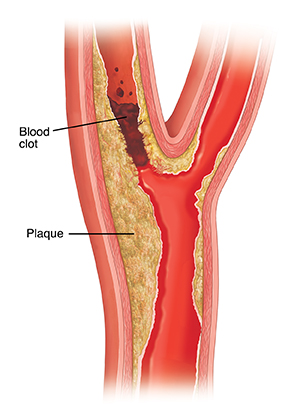
Know the symptoms of a stroke
-
Weakness. You may feel a sudden weakness, tingling, or a loss of feeling on one side of your face or body including your arm or leg.
-
Vision problems. You may have sudden double vision or trouble seeing in one or both eyes.
-
Speech problems. You may have sudden trouble talking, slurred speech, or problems understanding others.
-
Movement problems. You may have sudden trouble walking, dizziness, a feeling of spinning, a loss of balance, a feeling of falling, or blackouts.
Remember: If you have any of these symptoms, call 911 and your doctor as soon as possible.
B.E. F.A.S.T. is an easy way to remember the signs of a stroke. When you see the signs, you will know what you need to call 911 fast.
B.E. F.A.S.T. stands for:
-
B is for balance. Sudden loss of balance or coordination.
-
E is for eyes. Vision changes in one or both eyes.
- F is for face drooping. One side of the face is drooping or numb. When the person smiles, the smile is uneven.
-
A is for arm weakness. One arm is weak or numb. When the person lifts both arms and the same time, one arm may drift downward.
-
S is for speech difficulty. You may notice slurred speech or trouble speaking. The person can't repeat a simple sentence correctly when asked.
-
T is for time to call 911. If someone shows any of these symptoms, even if they go away, call 911 right away. Make note of the time the symptoms first appeared.
Hemorrhagic Stroke
What Is Hemorrhagic Stroke?
The brain needs a constant supply of blood to work well During a stroke, blood stops flowing to part of the brain. The affected area is damaged. Its functions are harmed or even lost. Most strokes are caused by a blockage in a blood vessel that supplies the brain (ischemic stroke). They can also occur if a blood vessel in the brain breaks open (ruptures). This is a hemorrhagic stroke.

How a hemorrhagic stroke occurs
Hemorrhagic stroke occurs when a blood vessel in the brain ruptures. This lets blood spill into or build up in nearby brain tissue. The extra blood presses on those brain cells. It can damage them or even cause them to die. Other brain cells die because their normal blood supply is cut off because of high pressure in the skull.

